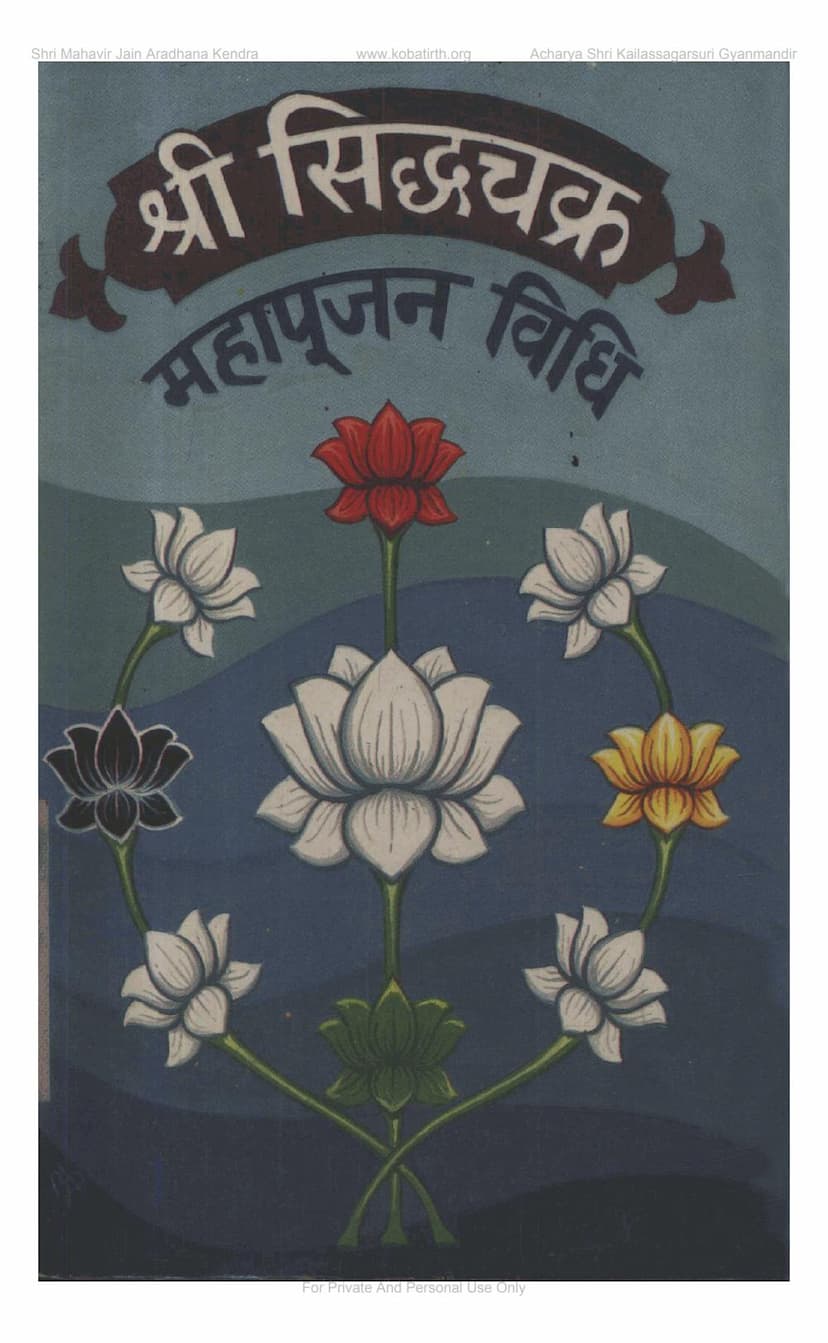Siddhachakra Mmahapujan Vidhi
Added to library: September 2, 2025

Summary
The provided text is a detailed Jain ritual for performing the Siddhachakra Mahapujan Vidhi (Grand Worship of the Siddhachakra). The Siddhachakra is a sacred diagram in Jainism representing the nine supreme beings or Navapada (Arihanta, Siddha, Acharya, Upadhyaya, Sadhu, Darshan, Gnan, Charitra, Tapa). The book, Siddhachakra Mahapujan Vidhi, authored by Arvindsagar and published by Arunoday Foundation, serves as a comprehensive guide for this elaborate worship.
Here's a summary of the key aspects presented in the text:
1. Purpose and Significance:
- The Siddhachakra is considered the most powerful tool in Jainism for breaking the cycle of birth and death (bhavachakra) and achieving liberation (moksha).
- Worshipping the Navapada through the Siddhachakra is believed to bestow spiritual merit, inner peace, and ultimately, the attainment of liberation.
- The text emphasizes that the Siddhachakra is the essence of Jain teachings and the path to ultimate spiritual achievement.
2. The Book and its Creation:
- The book is presented as a revised and improved edition of a previous publication.
- It highlights the efforts of various Jain scholars, monks, and devotees in compiling, editing, and ensuring the accuracy of the ritual.
- Special thanks are given to Muni Shri Arvind Sagarji for his keen interest and responsibility in publishing the booklet, and to Shri Sudesh D. Shah for the computer composition.
- The publication is a collaborative effort, with support from numerous individuals and organizations listed on page 4, indicating a community-driven initiative to make this knowledge accessible.
3. The Ritualistic Components: The text meticulously outlines the various stages and elements involved in the Siddhachakra Mahapuja, which is an extensive and intricate ritual. Key components include:
- The Siddhachakra Yantra: The book describes the structure and significance of the Siddhachakra diagram itself, emphasizing the central role of the 'Ah' syllable and the various concentric circles, petals, and deities within the diagram. The text delves into the philosophical interpretation of elements like the Kundalini energy and the significance of the 'Ah' with its specific configuration.
- Preparation: It details the necessary preparations, including the purification of the ritual space, the arrangement of various offerings, and the invocation of deities.
- Invocation and Installation: The ritual involves the invocation (ahavahan), installation (sthapan), presence (sannidhan), containment (sannirodhan), and final sending off (visarjan) of the deities associated with the Siddhachakra.
- Worship of the Nine Tattvas (Navapada): The core of the worship involves the adoration of each of the nine supreme beings with specific mantras and offerings.
- Worship of the Seven Circles: The text systematically describes the worship of various concentric circles within the Siddhachakra, which include:
- First Circle: The Navapada themselves.
- Second Circle: The eight vargas (groups of letters) and the saptakshari mantra (seven-letter mantra).
- Third Circle: The 48 labdhi-padas (powers/achievements) and eight anahata-nadas (unstruck sounds).
- Fourth Circle: The Guru-padukas (footprints of Gurus), representing the lineage of spiritual teachers.
- Fifth Circle: The Adhishthayaka Devatas (guardian deities) and associated deities like Yakshas and Yakshinis, including detailed descriptions of their forms, vehicles, and roles.
- Sixth Circle: The Jayaadi Deviyas (Jaya and other goddesses).
- Seventh Circle: The sixteen Vidya Devis (goddesses of knowledge).
- Eighth Circle: The Yakshas and Yakshinis.
- Ninth Circle: The four Dwarapalas (gatekeepers) and four Veeras (heroes).
- Tenth Circle: The ten Dikpalas (directions guardians).
- Eleventh Circle: The nine Grahas (planets).
- Twelfth Circle: The nine Nidhis (treasures).
- Various Pujas: The ritual includes specific pujas for each element and deity, such as Jal Puja (water worship), Chandana Puja (sandalwood worship), Pushpa Puja (flower worship), Dhupa Puja (incense worship), Deepa Puja (lamp worship), Akshata Puja (rice worship), Naivedya Puja (offering worship), and Phala Puja (fruit worship).
- Abhishekam (Consecration Bath): A significant part of the ritual involves bathing the deity or the yantra with various substances like milk, curd, ghee, sugarcane juice, fragrant water, and pure water, accompanied by specific mantras.
- Mantras and Stotras: The book contains numerous mantras and stotras (hymns of praise) to be recited at each stage of the worship. It also discusses the significance of specific mantras and their proper pronunciation.
- Chanting and Meditation: Emphasis is placed on chanting mantras and meditating on the Siddhachakra for spiritual upliftment.
- Symbolism and Philosophy: The text often delves into the philosophical and symbolic meanings behind the ritualistic elements, connecting them to concepts like Kundalini, cosmic energies, and the path to spiritual realization.
- Importance of Devotion and Purity: The text stresses the importance of devotion, purity of intention, and meticulous adherence to the ritualistic procedures for achieving the full benefits of the worship.
4. Guidance for Ritual Conductors:
- The book includes advice for the vidhikarak (ritual officiant), emphasizing the need for proper understanding, training under experienced gurus, and maintaining purity of mind, speech, and body.
- It also touches upon the importance of the correct sequence of rituals and the potential pitfalls of errors.
5. Supporting Content:
- Blessings: The book includes blessings and endorsements from various revered Jain scholars and monks, underscoring the importance and efficacy of the Siddhachakra worship.
- Materials List: A comprehensive list of materials required for the puja is provided, ensuring that devotees can prepare adequately.
- Explanations and Interpretations: Throughout the text, explanations are provided for the mantras, symbolism, and the underlying philosophy, making the ritual accessible to a wider audience.
In essence, Siddhachakra Mahapujan Vidhi is a sacred manual designed to guide devotees through a profound and transformative Jain ritual, enabling them to connect with the ultimate spiritual principles and achieve their highest potential.